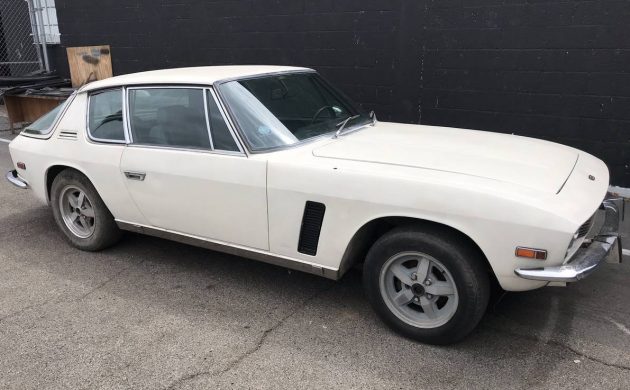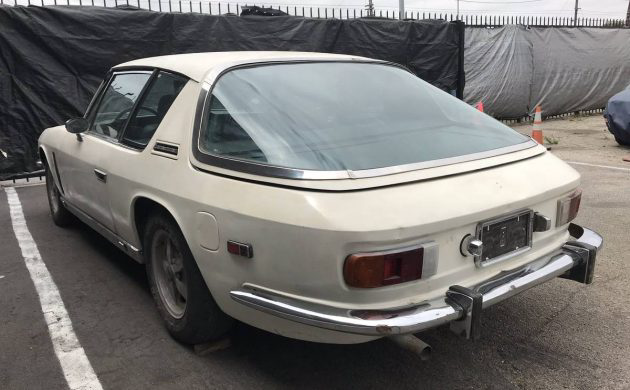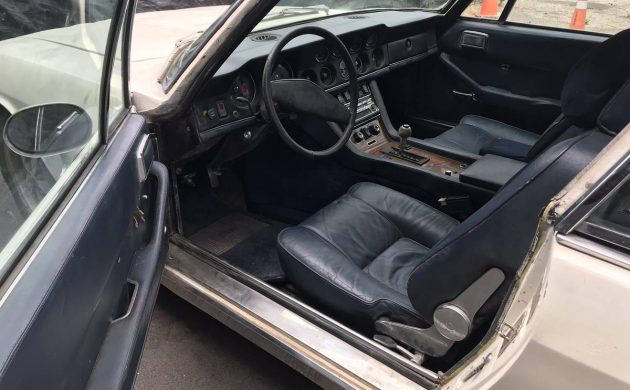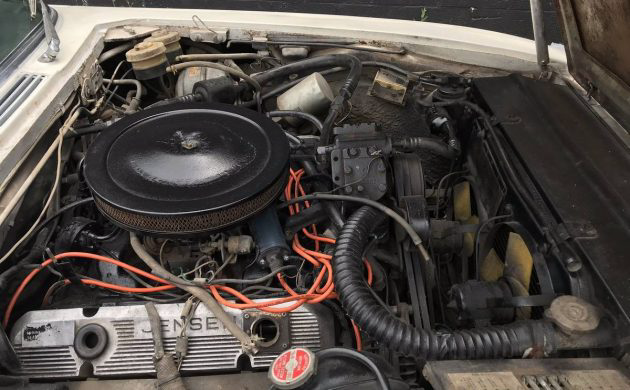This 1974 Jensen Interceptor is a a project, but one that remains in very nice condition despite being stored for 20 years. The seller contends the floors are among the best he’s seen in an Interceptor, and I have to say, these Anglo-American creations are usually in absolutely decrepit condition when they’re pulled out of long-term storage. In addition to the clean body, the engine still turns, too, but doesn’t fire at the moment. The seller has listed here on craigslist in Los Angeles with an asking price of $12,995 with only minor surface rust noted. Thanks to Barn Finds reader Rocco B. for the find.
The Interceptor is a classic design, and a bit of a bargain exotic when you stack it up against other limited production muscle cars of the era. When they’re restored, these Mopar-powered machines bring all the money, but in anything less than that kind of shape, it’s a slippery slope of finding a project that won’t put you in over your head in short order. The bodies can definitely rust, and the luxurious cabins can age poorly when not maintained. To find an unrestored project that has seemingly been kept in good order is definitely a rare find, and the asking price for an Interceptor this clean seems downright fair to me. The acres of glass and chrome trim both appear to be in great shape.
The interior is a highlight all by itself, as there’s plenty of wood trim and leather that can perish over time if the Interceptor is left in the sun or a damp garage. This car appears to have suffered from neither of those fates, as the leather still looks supple and the dash doesn’t even appear to show any cracks. The wood trim isn’t as lustrous as it once was, but it doesn’t look so far gone that it wouldn’t come back with some careful polishing. One detail that I can’t quite get a clear sense of is inside the door jamb, as the VIN plate appears to show some rough paint around the edges, but I’m not sure that’s a clear indication it’s been repainted. And honestly, vehicles of this age are a 50/50 chance of having been repainted at this point.
The engine bay is in very nice shape despite not running, but it sounds like it’s not far off from firing up again. The Interceptors predominantly relied on a 383 Chrysler-sourced V8, paired to a reliable Torqueflite automatic transmission. The optional 440 makes for a very expensive Interceptor purchase, but the 383 still delivered respectable power despite not being the top shelf engine option. Given the wide availability of parts and the seller’s note that it still turns over, the Interceptor certainly doesn’t seem all that far away from running down some backroads once again. Buy one while they’re still cheap!






I am not a Jensen expert by any means, could not tell you the difference between a Series I, II or III car but this is about the nicest one I have seen online – ever. Keep in mind:
1. 37,003 on the odometer could be 37,000 or 137,000. Doubtfull these cars could make it to 237,000.
2. White hides a multitude of body sins. Low quality photos of white cars hides even more.
3. The VIN plate does make it look like this one has been repainted. I would want to check carefully for evidence of body work.
4. Even with the engine not running, if the body is solid, the price seems reasonable.
5. I will always have a soft spot for white cars with any color interior other than black or tan. White with red is best but blue and green interiors are not far behind.
No black interiors for me and white cars look like refrigerators with wheels.
I love these cars, one of my favorites, someone buy this and enjoy it. You won’t regret it.
I don’t think the 440 motors was ever an “option” you could chose instead of the 383…. earlier cars were all 383 and they changed to the 440 some time in 1971 and then they were all 440s after that time.
These are cool cars and as the author notes, relatively affordable compared to other limited production European coach-built GTs with American muscle car power…
Seems like quite a bit of too much optimism here. This car is hideously expensive to restore. Look at picture 8 with rattle can black on the air cleaner and rattle can white overspray on window rubber, air intake and all edges around the engine compartment. That’s all I need to know to tell what’s under that white paint. The Interceptors are incredibly difficult to restore well as they were fully hand built. No replacement panel will ever fit without significant adjustments.
So, sorry but this car is unlikely to ever get back on the road again.
ClassicCarFan is right about the engines. Series 1 and 2 cars used the 383, but the series 3 like this car only got the 440. There were at least 3 different 440 versions, a standard one, a high performance 6-pack “SP” and then some cars that got the high compression engine from the SP but converted to a regular Holley 4-barrel carb. Back in the mid -80’s I owned a -73 with the last engine version. Certainly very powerful, but it really would have wanted octane booster as premium fuel wasn’t enough and fuel consumption ranged between 5-13 mpg…
ET Al
I have one of those sitting in garage….did a research…it (Mine) left the factory in 1974…to Milwalkee, WI…was green with vinyl top….with the 440. Am not sure about a “bear” to restoree….it was a Italian body …then shipped to Englanf for finishing….I have found many Jaguar items fit it…otherwise…it is very, very fast…I say a comparison of it with a Jag V12/Maserati/Lamborghini…it finished first…except for the ungodly consumption of fuel. Otherwise for the price….drive it while your Facel Vega/Aston Martin/300SL sit in the garage for a quarter of the price….AND cheaper insurance…..the mechanics…i,e engine/transmission (Chrysler), brakes (English..Dunlop.Girling..?)….I drive mine when I have enough money for gas…..A Jensen was featured in the movie (Richest Man in the World)…so so someone with some taste. My Citroen SM…while nice…not the reliability of the Jensen…..go figure
This car certainly looks to have travelled well beyond 37K. The VIN plate shows an 8/74 build. Most Jensen Interceptors manufactured at this time were Mark 3, “J” Series and had a louvered bonnet. This car does not have the louvred bonnet, nor does it have the “J” enamelled badges on the rear “C” pillar. Why is it missing the door seals and the front seats show signs of splitting. The body shows numerous signs of minor damage. The original engine number for this car was 4C12710. The engine number will be on the front drivers side of the block.The air cleaner is not original and half the engine bay has been sprayed black using a spray can and no masking. The oil filler cap and breather cap are missing off the rocker covers. It was interesting to see a wooden block under the rear drivers side wheel. This suggests it has no handbrake and maybe a problem with the “Park” position in the transmission. The exhaust system seems to be a budget build and does nor carry the large chrome tailpipes normally seen on Jensen Interceptor. Overall, I would describe this car as a project.
I had a 73 mk.lll back in the mid 70’s. Parts were very expensive even then and the car had a lot of design faults including a Lucas electrical system. The very tight engine compartment resulted in fried wiring and short battery life. On the good side — 440 engine, very nice interior, walnut dash, good A/C. And the greatest plus of all – women absolutely loved the car.